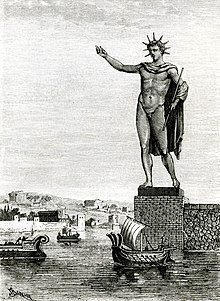Rhodian coinage

Ancient Rhodian coinage refers to the coinage struck by an independent
Rhodian monetary standard

Rule by Athens temporarily brought
By the end of the fourth century BC the Aegean region had been dominated by coinage using Attic and Rhodian standards.
Rhodian standard was later notably used in the transition to
Early Chian, or Rhodian, standard included tetradrachms and heavier coins. However, later coinage using Rhodian weight evolved with tetradrachms being abandoned in favor of smaller didrachms. Coins lost their weight both before and after the abandonment of the tetradrachms. Early tetradrachms and didrachms were 15.6 g and 7.8 g in weight respectively. They were both replaced in use by later didrachms with the minimum weight of 6.7 g.[6]
There is convincing evidence that Rhodian and Lycian league's plinthophoroi circulated, at least informally, at par on the market, and they have been found together in coin hoards. However, Lycian coinage's weight standard was slightly lighter than Rhodian standard.[7]
Mints
Rhodes itself held the most important mints.[8] Ephesus is notable for holding the most important mint for the Rhodian monetary standard outside of the Rhodian controlled territory.[8]
History of Rhodian coinage

Rhodes was a major maritime and mercantile power. For instance, Syrian goods on bound to Egypt made a detour through the island of Rhodes.[9] Rhodians also made large contributions to fight piracy in the region.[10] Rhodes was an ally of the Ptolemaic Kingdom.[11]
Siege of Rhodes (305 BC – 304 BC) by Demetrius I of Macedon resulted in Rhodians gaining wider freedom of action, and ties with Ptolemaic Egypt being strengthened.[12] The siege had been an attempt to break the Rhodo-Egyptian alliance.[11] However, tetradrachms and golden coinage originating from Rhodes disappeared for a considerable length of time. Rhodian didrachms (weighing 6,7g) gained a solid position, with its wide circulation, in the eastern Mediterranean trade. Its atypical weight did not allow the Rhodian didrachm to function as a real international means of exchange. Many Rhodian silver coins were also melted down in Egypt when spent there, and were subsequently struck as Ptolemaic coinage.[12]
Imitations of Rhodian coinage are proven to have circulated between 188 BC and 167 BC in Lycia on the mainland Asia Minor. These forged coins imitated an older variant of Rhodian coinage.[13]
During 88 BC siege of Rhodes by
End of the local currency
The final demise for the Rhodian currency was brought by the late Republican
Rhodes came under direct Roman rule in 31 AD and was merged in the
Iconography

Sun god Helios was the prominent deity for the Rhodians. Several ancient towns claimed descent from the deity. Helios would appear on obverse sides of Rhodian coinage for four centuries.[17][18] Designs of Rhodian coinage were unaffected by the campaigns of Alexander the Great.[17]
Rhodes used a head of Helios or a rose as their symbol. These symbols were also used in other forms of art, in addition to coinage,
Rhodian silver coinage may give hints on the appearance of the Colossus of Rhodes.[22]
See also
References
- ^ ISBN 0-8014-7597-X.
- ^ ISBN 978-0-19-937218-8.
- ISBN 978-1-108-02062-6.
- ISBN 978-1-108-07865-8.
- ^ Mørkholm 1991, pp. 68–69.
- ^ Mørkholm 1991, pp. 9–10.
- ISBN 978-0-19-163010-1.
- ^ ISBN 978-1-107-49754-2.
- ISBN 0-472-11109-4.
- ISBN 978-90-272-7854-8.
- ^ ISBN 978-1-134-80783-3.
- ^ a b Mørkholm 1991, pp. 90–95.
- ISBN 978-87-7288-676-3.
- JSTOR 42668015.
- ISBN 978-0-8018-5291-6.
- ^ ISBN 978-0-521-24354-4.
- ^ a b "Ancient coinage of Caria". snible.org. Retrieved 20 February 2018.
- ^ "Rhodian Plinthophoroi". www.cngcoins.com. Retrieved 20 February 2018.
- ISBN 978-1-316-43229-7.
- ISBN 978-0-521-21929-7.
- ISBN 978-0-521-39504-5.
- . Retrieved 20 February 2018.
Works cited
Mørkholm, Otto (31 May 1991). Early Hellenistic Coinage from the Accession of Alexander to the Peace of Apamaea (336-188 BC). Cambridge University Press.
